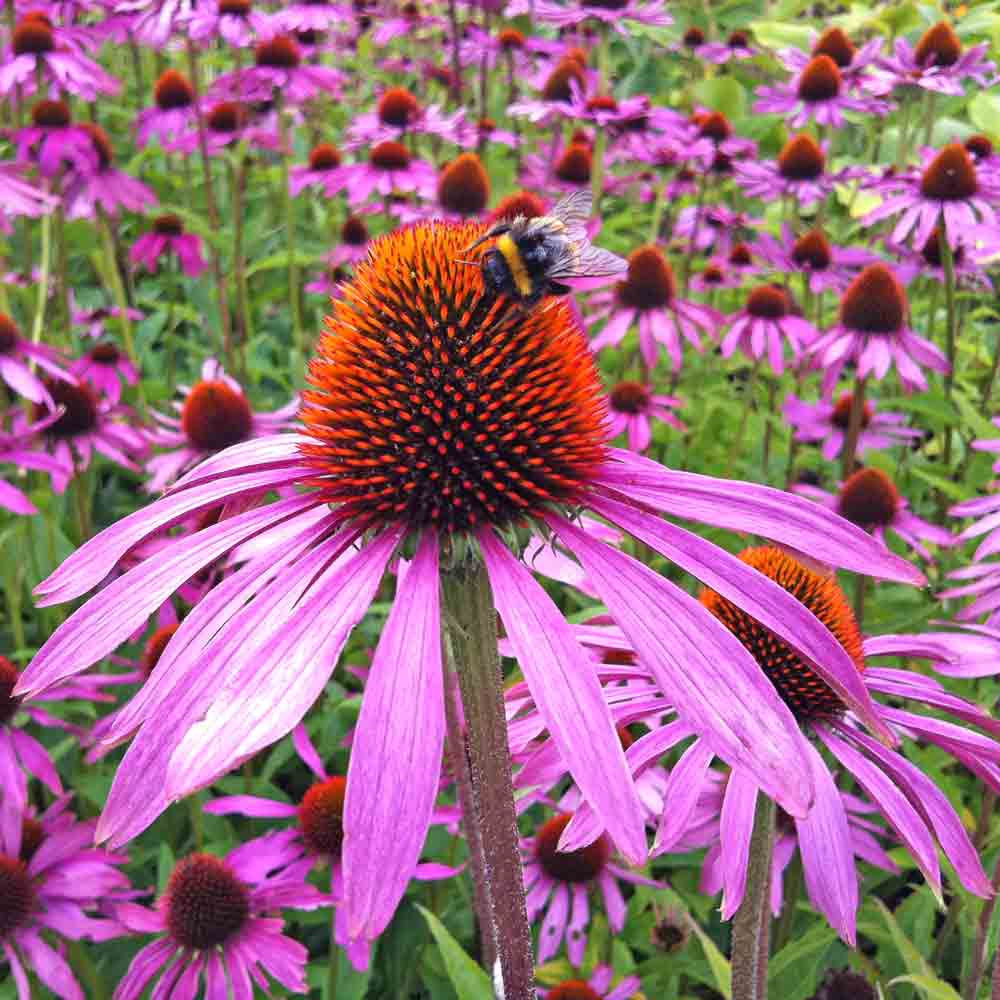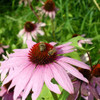Purple Coneflower Echinacea Seeds - (Echinacea purpurea)
- SKU:
- H1100
- Seed Count:
- Approx 100 seeds per pack
- Type:
- Perennial
- Days to Germination:
- 10-21 days @ 65-70F
- Light Preference:
- Full sun or light shade
- Soil Requirements:
- Well-drained rich soil
- Plant Spacing:
- 24"
- Status:
- Heirloom, Non-Hybrid, Non-GMO seeds
Description
Purple Coneflower Echinacea - Cornerstone Species for Ecological Gardens
Think of Purple Coneflower as the Prairie Powerhouse of your perennial border. Drawing resilience from its deep North American roots, this plant delivers reliable, spectacular beauty with remarkable ease, thriving across a wide range of conditions. But this native’s true strength is how it becomes the ecological hub, drawing vital life and energy into your entire garden ecosystem. Its iconic, nectar-rich blooms are essential fueling stations for countless bees and butterflies (especially Monarchs), while simultaneously inviting beneficial predatory insects that act as your garden's natural security team. Tough, adaptable, ecologically crucial, and stunningly beautiful – this easy-care perennial works hard supporting the whole system so you (and your garden's helpful critters) can thrive.
Details
Widely known and cherished as Purple Coneflower, this prominent North American herbaceous perennial is a cornerstone of prairie-style and pollinator gardens. Growing in upright clumps, this Aster family member typically reaches 2 to 4 feet tall (occasionally up to 5 feet) with a spread of 1.5 to 2 feet. Plants have a characteristically coarse, rough-hairy texture throughout. The dark green leaves are arranged alternately, generally ovate to broad-lanceolate with serrated edges, becoming smaller up the stem; leaf length ranges from 2 to 10 inches.
From summer through early fall (typically June-September), the sturdy stems are topped with large, daisy-like composite flower heads, often up to 5 inches across. These feature slightly drooping ray florets ("petals") in shades of purplish-pink, surrounding the distinctive, spiny, brownish-purple or coppery-orange central cone that gives the genus its name (Echinacea from the Greek echinos, hedgehog). Unlike some related coneflowers, this species has a fibrous root system, making established clumps easier to divide. Following the flowers, the cones hold seeds that are highly sought after by birds, particularly goldfinches, in the fall and winter. It is reliably perennial in USDA Zones 3-8, potentially up to Zone 9. Common names include Eastern Purple Coneflower, Hedgehog Coneflower, and simply Echinacea.
History
Purple Coneflower (Echinacea purpurea) is native to the tallgrass prairies, meadows, thickets, barrens, and open woodlands of eastern and central North America, with roots firmly in the American prairie ecosystem. While widely planted and sometimes naturalized beyond this original range, understanding its origin is key to appreciating its resilience. Its conservation status is generally considered secure, though wild populations face pressures from habitat loss and harvesting. Distinct from its taprooted relatives like E. angustifolia, this species' fibrous roots contribute to its wider adaptability and ease of cultivation.
European naturalists began documenting Purple Coneflower's journey into botanical records, starting with Reverend John Banister sending seeds from Virginia to England around 1699. Famed botanist Carl Linnaeus initially classified it as Rudbeckia purpurea in 1753, before Conrad Moench gave it its current genus name, Echinacea, in 1794 – referencing the distinctive "hedgehog" (echinos) spiny central cone. The plant's significance was also noted by the Lewis and Clark Expedition, who sent samples back to President Jefferson in 1805.
Purple Coneflower held deep cultural significance for various Native American tribes. It was valued not only for diverse traditional medicinal applications but was also used in purification ceremonies and for practical items like combs crafted from the seed heads. European settlers learned of its properties from Indigenous peoples, leading to its unique status as a native prairie plant adopted into both folk and formal medical practices. The marketing efforts of Dr. H.C.F. Meyer ("Meyer's Blood Purifier") and its promotion by Eclectic physicians in the late 1800s propelled Echinacea to become the most widely used herbal remedy in the US by the early 20th century, though its popularity temporarily declined after the advent of antibiotics.
Introduced to European gardens possibly as early as the late 17th century and certainly valued there by the late 1800s, Purple Coneflower continued its journey. Commercial cultivation began in Germany and Switzerland by the mid-20th century. Today, it remains a beloved garden perennial worldwide and a popular herbal supplement, linking modern gardens back to ancient prairies and underscoring the importance of preserving these culturally significant plants through efforts like the Cherokee Nation Seed Bank.
Uses
Purple Coneflower offers multifaceted value. Its primary appeal lies in its outstanding ornamental quality – the large, showy, purplish-pink flowers provide long-lasting color from mid-summer into fall, adding structure and texture to borders and naturalistic plantings. They pair beautifully with ornamental grasses, Rudbeckia, Salvia, and other prairie natives.
Ecologically, this plant is a powerhouse for attracting pollinators. Its nectar-rich flowers are magnets for bees (honey, bumble, native), butterflies (including Monarch, Painted Lady, and Fritillary), and sometimes hummingbirds. Planting it directly supports these vital species. Furthermore, Purple Coneflower provides valuable habitat and resources for predatory insects like lacewings, hoverflies, parasitic wasps, and ladybugs, contributing significantly to biodiversity and natural pest management in the home garden.
While the Echinacea genus is famous for traditional herbal use (particularly immune support), exploring specific medicinal applications requires consulting qualified experts, as efficacy and safety depend heavily on species, preparation, and individual health.
Companion Planting
Purple Coneflower excels when planted with companions sharing its preference for full sun and well-drained soil, such as prairie natives like Rudbeckia, Liatris, Solidago, Asclepias, and various ornamental grasses. Ensure good air circulation between plants. Avoid planting with deep shade lovers or plants needing consistently wet soil. Remember to follow good crop rotation principles regarding its Aster family relatives (like sunflowers or lettuce) if rotating annuals nearby.
Planting and Growing Tips
Valued for its reliability, Purple Coneflower prefers temperate conditions but shows considerable adaptability, including some heat tolerance (afternoon shade helps in hot climates). It thrives in full sun (6+ hours preferred) but tolerates light shade. Excellent soil drainage is crucial, especially in winter. While adaptable to various soils, it performs best in loam amended with organic matter.
Starting from seed requires patience, as germination can be slow and sometimes erratic. While not always essential for this species, cold, moist stratification for about 4 weeks typically enhances germination rates. Direct sow seeds outdoors in fall or early spring after the soil warms to ~65°F, barely covering with soil. Be patient, as seedlings may not bloom reliably until their second year, as they focus on root development in the first year.
Water consistently the first season to establish roots. Once established, Purple Coneflower is quite drought-tolerant, needing water mainly during prolonged dry spells. It's a light feeder; avoid over-fertilizing. An annual compost top-dressing is usually sufficient. Mulch helps conserve moisture and suppress weeds. Deadheading is optional – it may encourage rebloom but removes the bird-feeding seed heads. Divide clumps every 3-4 years if needed (easier due to fibrous roots). Cut back dead stems in late fall or early spring.
For container growing, Purple Coneflower adapts well. Due to its root system (though fibrous), choose a deep pot (at least 12 inches deep and wide) with excellent drainage. Use quality potting mix, water consistently, fertilize very sparingly, and provide winter protection in cold zones.
Potential Challenges: While robust, watch for powdery mildew (promote airflow), leaf spot (remove affected leaves), or Aster Yellows (remove/destroy infected plants immediately!). Manage occasional pests like Japanese beetles or aphids organically. Good drainage and avoiding overly rich soil help prevent root/crown rot.
Harvesting Tips
For cut flowers, harvest stems when blooms are fully open; they offer good vase life. Deadheading faded blooms is optional for garden appearance and potential rebloom. Alternatively, leave seed heads standing through fall/winter to provide crucial food for goldfinches and other seed-eating birds, while also adding architectural interest. Seeds can be saved from these open-pollinated plants (ensure isolation if growing multiple Echinacea species/cultivars). Remember to wear gloves if you are sensitive to the plant's fuzzy texture.
Learn More
From the soil to the seed to the food you eat - we'll help you grow your best garden!
















